Garden yucca: varieties, planting and care
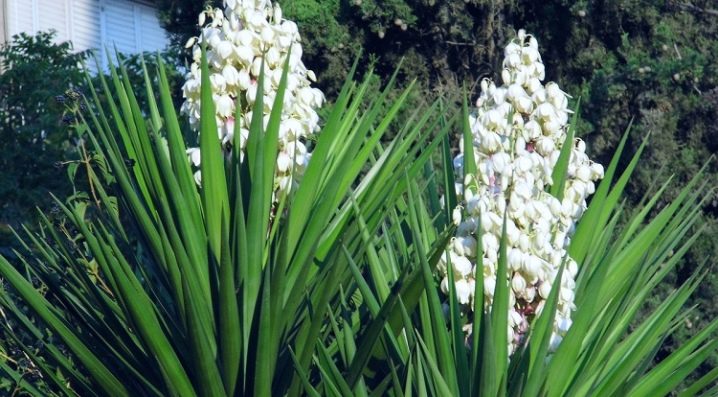
Unusual plants in the summer cottage are becoming more and more in demand. One of these original and exotic representatives of the flora can be called garden yucca. It is distinguished by an interesting form of flowering, which allows it to be a desirable design option for designers of summer cottages, amateur gardeners. Yucca has been growing in our country for a little over a century, and has long gone beyond palaces and mansions. In modern realities, yucca can be used to decorate any summer cottage; it is planted in parks and squares of the city.
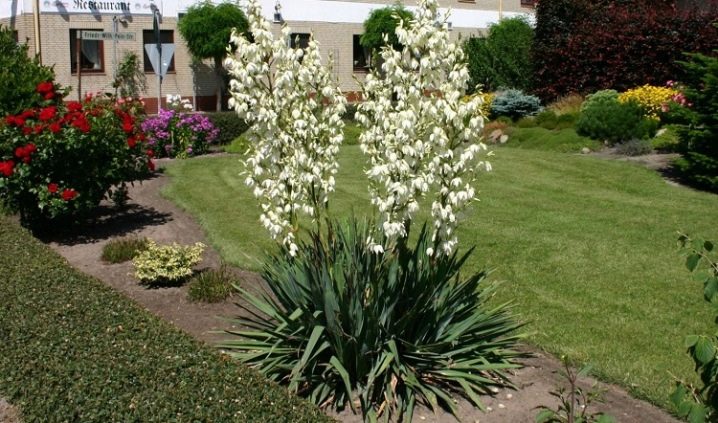
Description
Originally, this is an original plant from the subtropics and tropics of America, but in fact it turned out to be not too whimsical, and perfectly took root in the harsh weather of our region. In her usual environment, yucca has learned to endure temperature extremes and drought. Of course, planted under the open skies of the middle zone of the country, yucca requires special care during the winter months. As for the southern part of the country, yucca is perfectly capable of surviving a slight subzero temperature, and is not insulated for the winter.
Garden yucca is otherwise called filamentose, it comes from the Agavov family. This flower belongs to exotic species, it is a perennial shrub of a tree type. The foliage of the bush is tough, sword-shaped, formed into a dense rosette, spiraling in it. Foliage can have different shades - from green to bluish color, the size reaches one meter. Inflorescences form on a panicle that grows from the middle of the rosette. Flowers of a drooping type, milky, white, yellow, and even pink, resemble bells outwardly. Each inflorescence can be up to 5 cm wide and 7 cm high.
As the lower leaves wither, dry up and hang, they form a kind of skirt that surrounds the trunk. Flowering with proper care is annual, abundant, the height of the shrub is from one and a half to two meters. The number of flowers on a panicle in one season is up to 200 pieces. At the end of flowering, seeds are formed.
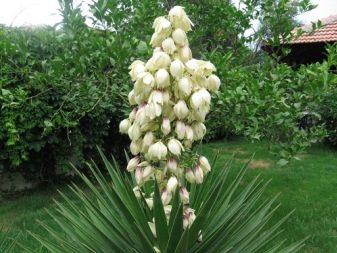

Varieties
Open ground can grow two main types of yucca: gray, it is also called the "Lord's Candle", and filamentous. Street yucca has many hybrids, among which flower growers distinguish:
- "Color Guard" - a plant with wide and flat yellowish leaves;
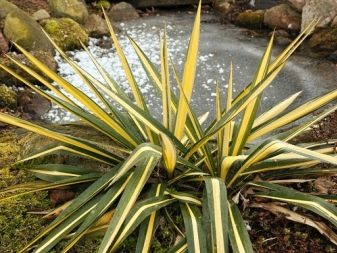
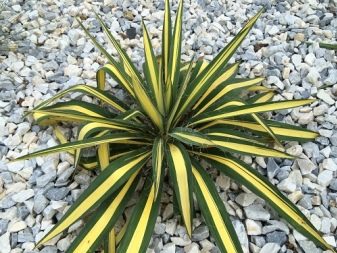
- Bright edge - view with bluish leaves bordered with a crimson ribbon;

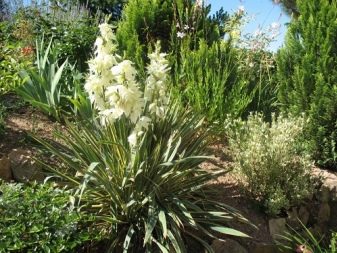
- Gold heart - this yucca is distinguished by yellowish-green leaves with indistinct borders;
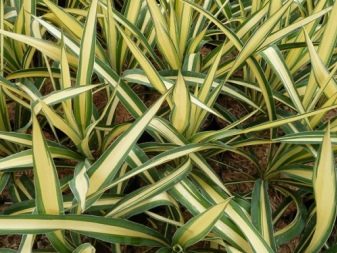
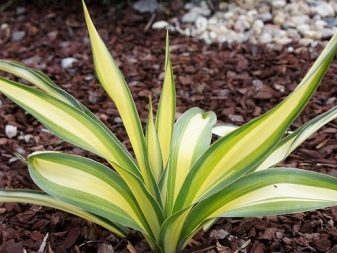
- Ivory Tower - yucca with greenish foliage and a clear white border.
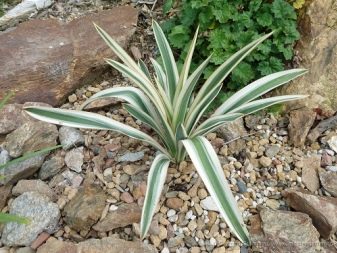

Yucca gray
This representative of the flora is characterized by the following features:
- short barrel;
- long, reaching almost a meter, foliage;
- leaves of a gray-green hue with lightened edges;
- white-greenish or yellow flowering, inflorescences of a narrowed type, small in size;
- broom-peduncle, reaching a height of 3 meters.
Gray yucca is unpretentious in relation to the soil, it can take root in sandstone, it tolerates small frosts, dry weather, but a large amount of moisture can undermine its health.
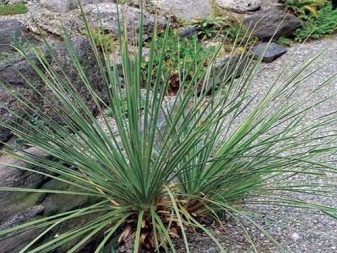

Yucca filamentous
Features of the filamentous look:
- foliage like a sword, up to 70 cm long, up to 10 cm wide;
- the border of the foliage is threadlike, bends back along the edge;
- flower-bearing panicle that does not grow higher than 2.5 m;
- inflorescences are white-beige, in the form of drooping bells.
This variety is even less capricious than gray-gray, calmly withstands severe frosts, but no more than minus 20.
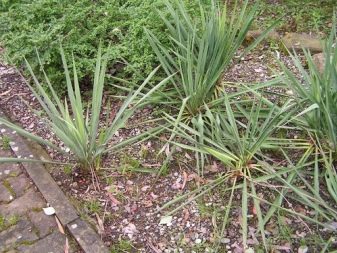
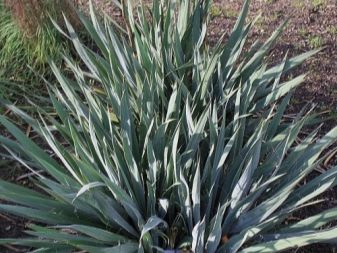
Landing
You can plant yucca everywhere, except for the harsh north: in the Moscow region, in the southern and middle climates. Gardeners do not recommend transferring the plant to the soil under the open sky immediately after purchase. Measures are needed to adapt the garden flora to future realities, that is, hardening. You should start by taking the container out into the air for several hours, gradually increasing the "walking" period. After about a couple of weeks, you can start planting a future flower in the garden.
It is necessary to carefully approach the choice of location. In order for the shrub to flourish, shady areas should be excluded, opting for high and lighted areas. Otherwise, the flowers will be loose, the foliage will become thinner, turn pale, and may stretch out. Yucca feels great in the sun, so it is better for her to highlight the area of direct rays, where it is difficult for other flowers to be.
If there are drafts in the country, this will have a bad effect on the condition of the bush, the exotic southern flower does not like cool winds, and gusts will easily break the fragile flowering.
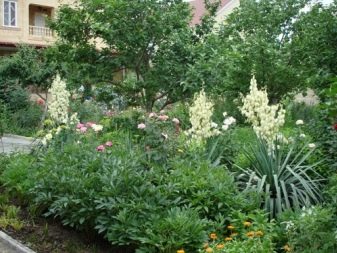
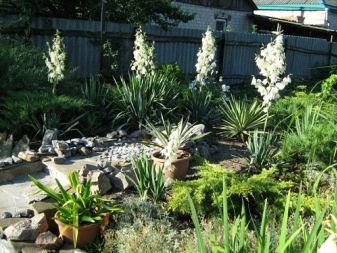
The ideal soil for this type of plant is loose, without a lot of clay, the following types of soil are well suited:
- rocky;
- sandy;
- black earth;
- with lime.
In the case when dense clay soil prevails on the site, it should be loosened and diluted with additives in the form of sand or peat. Yucca is afraid of moisture, therefore it is necessary to select zones in which the groundwater is not too high. That is why landing in a lowland is contraindicated.
As for the temperature regime, the absence of too sharp jumps can be considered optimal; an established temperature of 15 to 22 degrees Celsius is suitable.
The shrub, at the same time, can easily endure heat up to +35, drought.
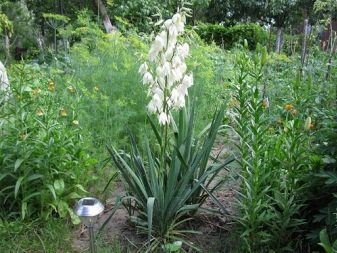

The landing procedure is as follows:
- a pit breaks out: a small one for a young plant, a larger one for a mature one, the approximate parameters of the pit are from 70 to 100 cm in width, up to 50 cm in depth;
- yucca is planted in the spring, but it is better to prepare the soil for this in the autumn;
- the bottom of the hole is lined with a drainage layer, you can take gravel or expanded clay with wood ash, two handfuls are enough;
- the optimal landing period is May, in any case, the average daily temperature should be above 10 degrees;
- install the shrub in the hole, straighten the roots, sprinkle with soil on top;
- the neck of the root should be at the same level as the edge of the groove;
- the plant is moistened and mulched with dry soil in a circle, so moisture will remain longer, there will be less weeds.
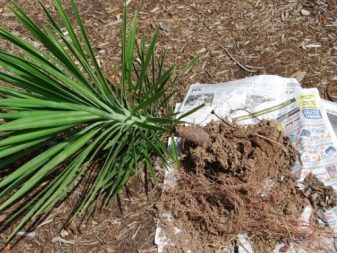
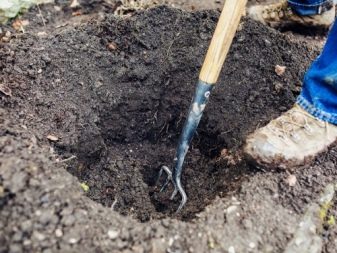
Care
Growing a tropical flower outdoors is not too much of a hassle, but you need to take care of it regularly for the plant to bloom and be healthy.
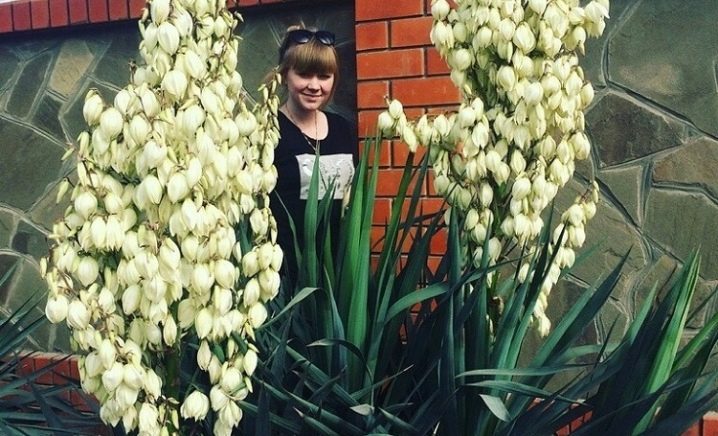
Watering
For optimal outdoor life, the yucca should be watered not too often, but regularly. Before watering the plant, you need to assess the top layer of the soil - it must completely dry out.
From time to time, foliage can be sprayed, moistened, wiped, but this should not be done during the hot part of the day.
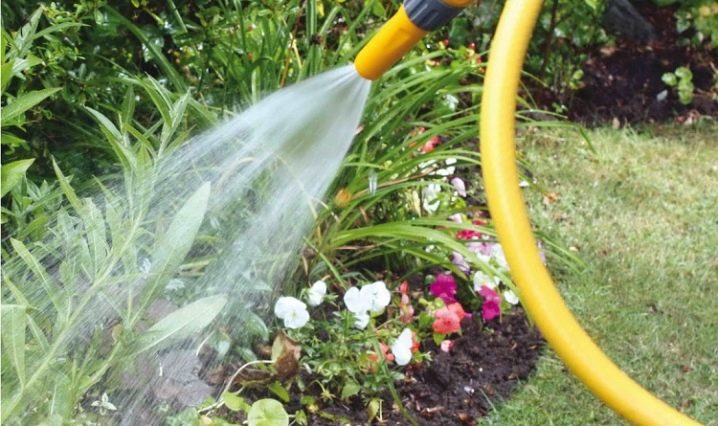
Top dressing
Undemanding flora does not require frequent fertilization. Top dressing is carried out only during the period of active growth twice. As fertilizers, you need to choose mineral complexes that are suitable for succulents. First, the plant is fed during the May growing season, then after the beginning of flowering.

Transfer
It is recommended to deal with the transfer of yucca after its long stay in one area, when it grows significantly. The new place will give the flower a burst of fresh energy, it will begin to bloom brighter and more intensely. But transplanting too often is still not recommended. To transplant a yucca, gardeners are advised to follow these recommendations:
- it is better to transplant this plant either in the spring or at the very end of the summer period;
- it is necessary to release the yucca from the soil extremely carefully, without causing damage to the root system;
- roots can grow quite deep into the soil, this must be taken into account;
- shoots located next to the shrub are planted separately;
- when choosing a new location, consider the same parameters as when choosing the original location: illumination, warmth, height.
After a couple of weeks, feed the yucca with complex fertilizers.
You can expect flowering after the procedure in three years.
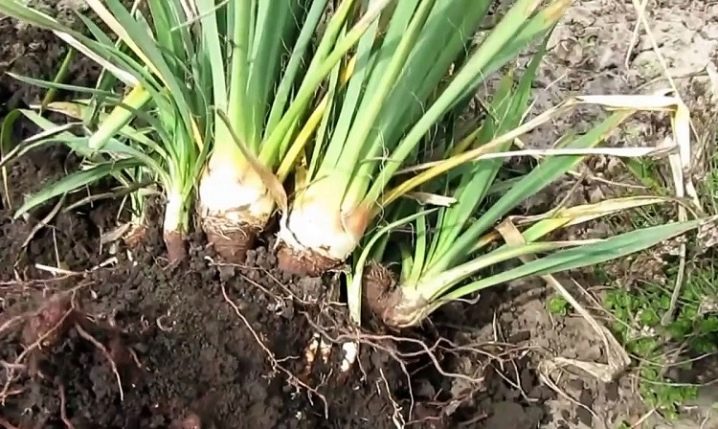
Reproduction
You can propagate garden yucca in different ways:
- shoots;
- seeds;
- stem;
- by cuttings.
It is easiest for inexperienced gardeners to propagate the yucca by separating the shrub, transferring it to a new place. In late spring, the shoots are separated. The separated shoots with roots and shoots are transferred to the selected area, then moistened.
Careful care of newly planted shoots is needed: moisture, rare dressings, partial shade are required.
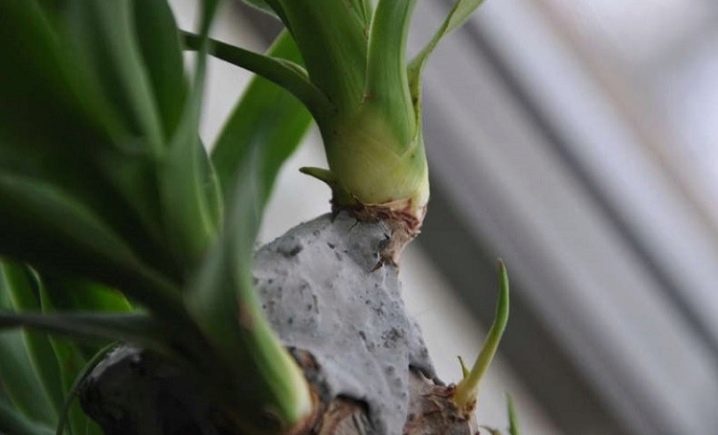
The stem propagation algorithm is as follows:
- a place is selected above the neck of the root, where part of the trunk is cut off;
- it is dried, planted in sandy soil or in perlite in a horizontal manner;
- it is necessary to root the stem in a warm place;
- near the root, the soil should be moistened;
- after the appearance of shoots and roots, the stem must be cut and planted in the soil;
- each of the separated stems must be sprouted.
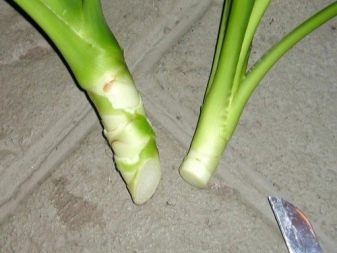
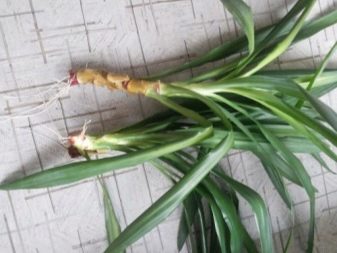
Cutting is carried out according to the following rules:
- the top of the stem with leaves is cut off;
- the container is filled with perlite, river sand;
- the cutting should be dried, planted in this container;
- spray the soil with warm water, keeping it moist.
Yucca garden at the end of flowering sets seeds, they need to be collected at the end of summer. There is another way - to buy seeds in any specialty store. Seeds up to one centimeter in diameter are round in shape. In order for them to ascend, they are seated in a mixture of sand, leafy and turfy soil in equal parts. In a month, you can expect seedlings, and when the first leaves appear, they dive into small containers. In full-fledged pots, the plant is planted already strengthened, grown up.
The garden yucca propagated in this way will begin to bloom 3 years after planting.
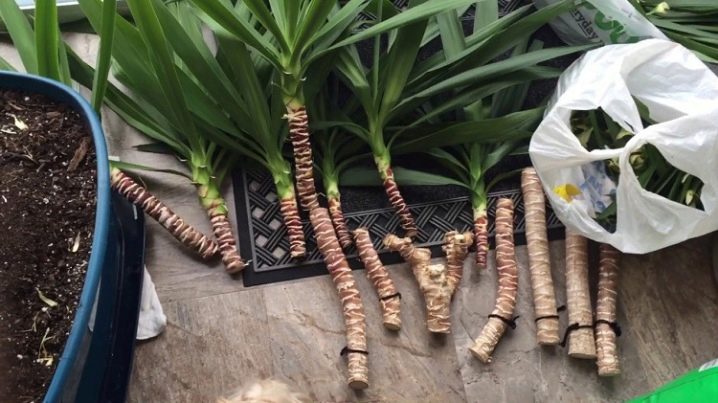
Wintering
Since yucca is of tropical origin, the question of whether it is necessary to cover it for the winter is very relevant among gardeners. In the middle zone of the country, filamentous and gray-gray yucca take root well, they do not need to be dug out, as they are frost-resistant. In the south of the country, the shrub does not require insulation; in regions with colder climates, the plant must be covered in frost. Warming should be done either in the last week of October or in the first week of November.
You need to wait for dry weather, collect the plant in a bundle and tie it with some kind of rope. Leaves are placed under the plant, and so that the ground does not freeze, dry foliage must be poured on top. Wooden sticks or boards are placed on top of the leaves so that the wind does not blow away the foliage. After tying, you need to cover the yucca with plastic wrap and sprinkle with earth at the bottom of the trunk.
You can insulate the plant using a wooden box. The top of the box should be covered with any non-woven insulation: roofing material, foam. On top of this material, the structure is covered with straw, foliage, coniferous branches, and covered with polyethylene.
The insulation is removed as soon as the time of frost and frost passes, at any time of the day.
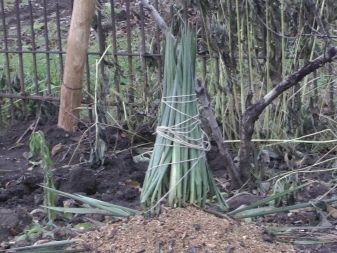
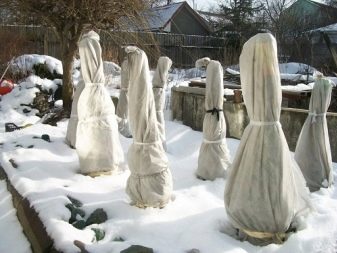
You need to cut the plant and form a bush in the spring, as soon as the snow melts and the shelters are removed. After cutting, the buds will begin to develop and new rosettes will appear. With the help of pruning, the flower is rejuvenated, strong seedlings are obtained, rotten and frozen shoots are destroyed. Before pruning, the plant must be watered and cut with a very sharp and clean blade. It is necessary to cut the cut in the place where the stem is not damaged, there are no cracks, delamination on the bark. Choose a place at least 8 cm below the foliage growth. After drying, the stump and sections should be treated with a mixture of charcoal powder and fungicide.At the very top, a garden pitch is applied, which serves as a "protector".
After three weeks, fresh sprouts should appear, if the plant is healthy, you can leave 3-5 buds, which have already hatched. Small buds are removed so as not to interfere with the growth of the main shoots. The cut off top can be used as a new seedling, the care of which is similar to transplanting individual shoots.
The seedling must first take root in the greenhouse.

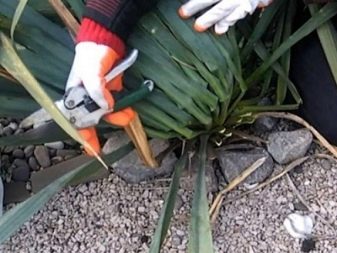
Diseases and pests
Since garden yucca comes from the tropics, despite its unpretentiousness, it does not like many factors. If you notice that the plant behaves in a strange way: the leaves are down, they turn yellow, it is necessary to exclude factors such as:
- draft;
- excessive moisture, including cold water;
- cold soil;
- violation of the root system.
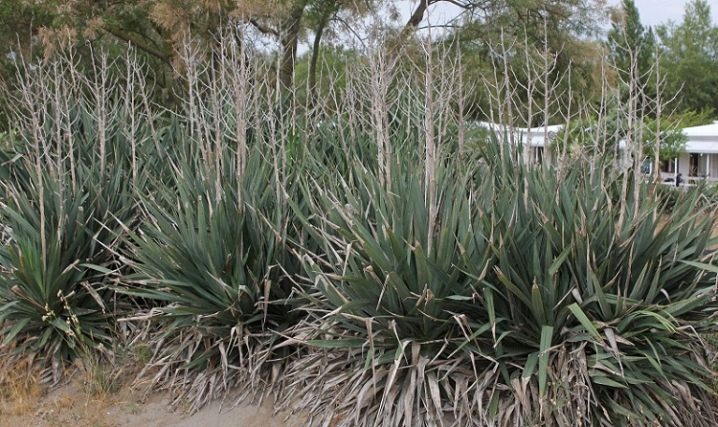
Waterlogging of the soil can lead to the initial stage of decay of the root system, especially if this factor coincided with hypothermia. And this, in turn, guarantees the death of the yucca. At first, the foliage withers, begins to fall off. Therefore, if you notice the corresponding signs, you need to take action:
- extract yucca from the soil;
- remove damage;
- carry out treatment with a disinfectant;
- after drying, the yucca is transplanted into the ground, but preferably in another place.
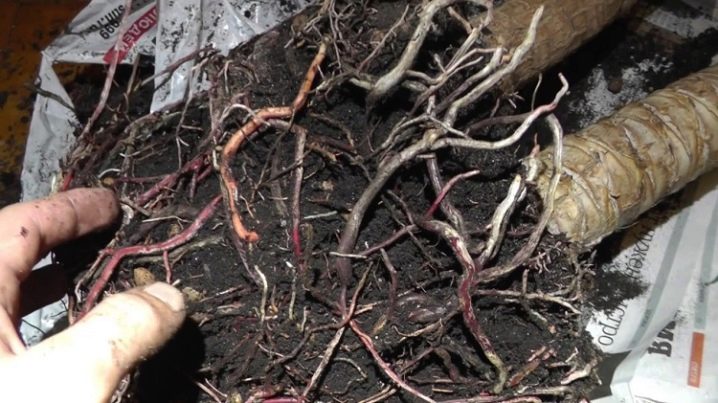
Often the root system suffers from pests:
- scabbards;
- spider mite;
- aphids;
- mealybug.
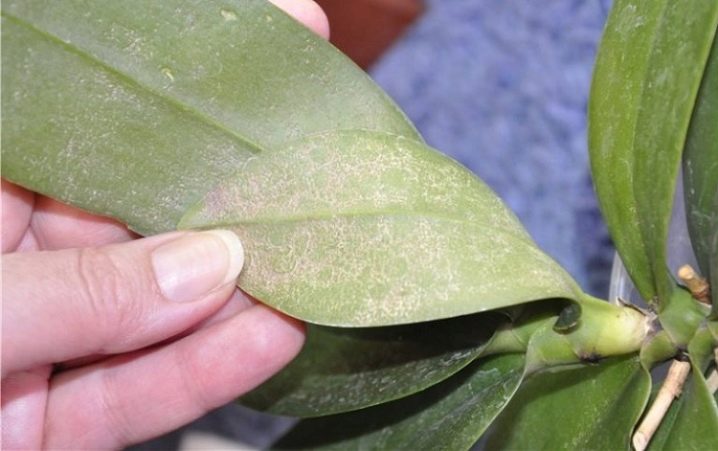
To save the plant from attack, you need to treat it with any insecticide. Before treatment, all lesions must be washed with soapy water. The best pest control products:
- "Karbofos";
- Aktara;
- Iskra Bio.
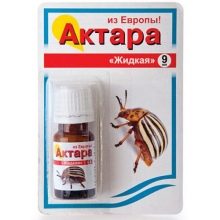

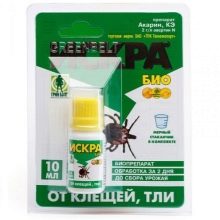
There are external signs that you need to pay attention to right away, as they can lead to sad consequences.
- If the foliage turns brown, then most likely the air is too dry or the plant is exposed to drafts. Insufficient watering is possible.
- Spots lighter than the usual type of foliage mean a burn, probably the direct rays of the sun burned the plant.
- If the leaf curls, it means that the plant does not have enough heat, it freezes.
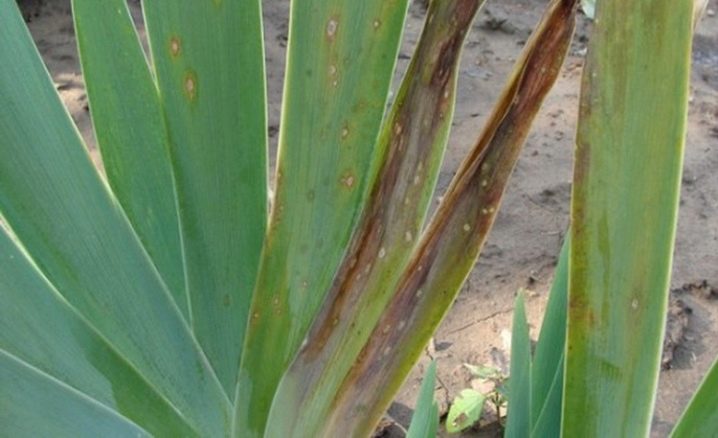
Yucca can be affected by a fungal type disease - anthracnose. In this case, the leaves are covered with brown-brown spots with a yellowish border. The spots have a convex shape at the edges, gradually they become larger. The cause of this disease is waterlogging of the plant. Perhaps the plant is being sprayed too often. In this case, you need to treat the yucca with any antifungal spectrum drug, destroy drafts, thin out the vegetation growing nearby, providing access and air circulation. The soil is also treated with special solutions. The remedy for the fungus "Saprol" and the solution "Fundazol" have proven themselves well. If these procedures do not have the desired effect, the vegetation is removed.
A whitish bloom on the foliage signals a powdery mildew attack. Most often, this fungal disease threatens young plants. Therapeutic measures are similar to anthracnose. It is also very effective to spray plants with "Topaz", "Skor" about once a week. Carrying out any therapeutic measures, you need to track the dynamics. In the case of a positive effect, the growth will be healthy.
And when young shoots are also affected by the fungus, they should be cut off.
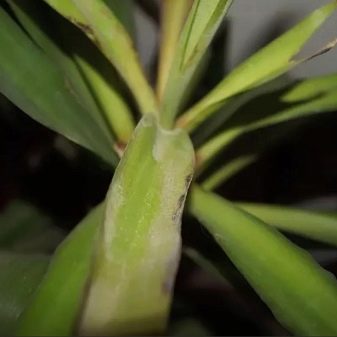
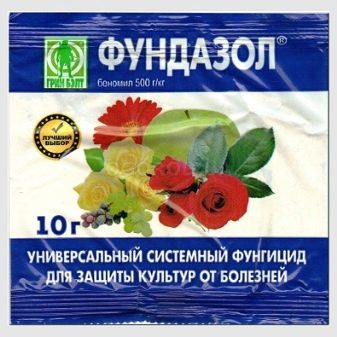
For information on how to plant Yucca garden, see the video below.






























I am a beginner gardener, I bought 3 adult yucca plants, after a week they began to die off - the lower leaves turn yellow and dry. What to do? Share your experience ... Thank you
Valentine, first of all, the reason may be stress or lack of light. Another reason is the wrong watering regime. Timely transplanting a flower will save its root system. Watering should be rare and only after the soil has completely dried out. In winter, watering is reduced to 1 time in 3-4 weeks. There should be not a lot of water, and the excess should be immediately removed from the pallet. The next reason is the temperature: comfortable for the plant is 20-25 ° in summer and 15 ° in winter, because in winter, the flower sleeps. If the leaves turn yellow in winter, then perhaps the pot is near the battery, the palm is hot, and the air is dry. Root decay is also accompanied by a sharp yellowing and foliage shedding. The leaves begin to turn yellow and fall off, starting from the lower ones. This process can occur due to the regular overflow of the flower. If a lot of excess liquid flows from the pot into the pan, the soil at the bottom of the pot will be constantly moist. Excess moisture provokes rot of young roots. Or too frequent watering: if the soil does not completely dry out between waterings, the roots suffer from an excess of moisture. Watering is especially often disrupted in winter, when the temperature drops, and watering does not decrease. Watering too much will also cause rot, even if not too much water flows into the sump. With abundant watering, rot can immediately go to the trunk when water collects at its base. And another reason is the lack of drainage. The holes in the bottom of the pot should be large, about 5 cm, so that air can also flow there, this can protect the yucca from moisture accumulation.
The comment was sent successfully.